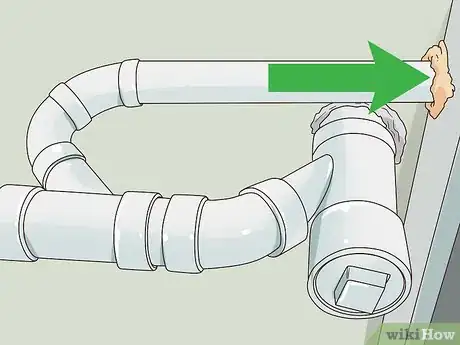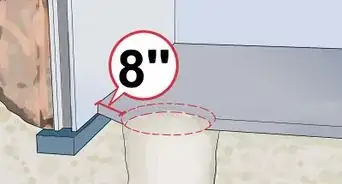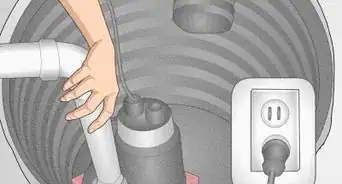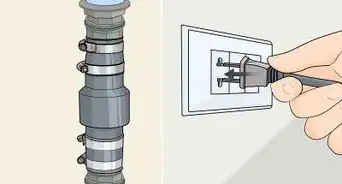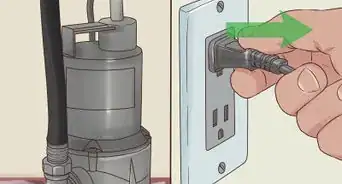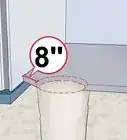This article was co-authored by David Balkan. David Balkan is a Professional Plumber, CEO of Balkan Sewer and Water Main Service, and President of Balkan Sewer and Drain Cleaning. As a hands-on owner of these companies for over 40 years, David is knowledgeable about water service lines, sewers, and drain line issues. David is a Committee Chairman of the Master Plumbers Council and has sat on the Executive Committee of the Sub Surface Plumbers Association of New York for over 30 years. His knowledge and solution-oriented approach contributed to Balkan Sewer and Water Main Service being the largest and most trusted service in New York City and the recipient of the 2017 Angie’s List Super Service Award.
This article has been viewed 45,274 times.
Houses in rural or unincorporated residential areas that are not a part of a sewage system typically have a septic tank to hold their sewage. These tanks need to be dug up and drained every few years. However, the location of septic tanks can be notoriously tricky to pin down. If you’re not sure of the location of your septic tank, you may be able to find it by contacting the county or the builder. Otherwise, you’ll need to physically look for signs of the tank.
Steps
Inquiring about the Tank’s Location
-
1Request the septic tank location information from your county Health Department. The Health Departments of counties throughout the U.S. keep detailed housing records, which include the locations of each house’s septic tank. Reach out to the Health Department for a copy of this information.[1]
- You can find the phone number, physical address, or email address of your county’s Health Department online.
- For example, if you live in Anne Arundel County, Maryland, you can find their septic-tank request form here: https://www.aahealth.org/request-for-copies-of-septic-or-well-records/.
-
2Get in touch with the contractor who built the house. If your house was built within the last 5-10 years, the contractor may remember off the top of their head. If your house is older, it’s still likely that the contractor will have a diagram showing where your septic tank is located. Ask them to access this diagram and let you know about the tank’s location.
- The best way to find the contractor’s name or company is to look on old blueprints or any other documents that you (or the original owner) kept from when the house was first built.
Advertisement -
3Ask your neighbors where their septic tanks are located. If your house and yard are structured similarly to others in your subdivision, your septic tanks may be the same direction and distance away from your respective houses. Talk to 2 or 3 of your neighbors and ask them where their tanks are located.
- If your neighbors are generous with their time, they may be willing to walk out in their yard and show you the exact location where their tank is buried.
-
4Inquire with the house’s previous owners. If you know who owned your house before you, contact them and ask if they remember the location of the septic tank. If they lived in the house for more than 4 or 5 years, odds are they had the septic tank drained and will remember its location.
- Even if they don’t remember the tank’s exact location, they may be able to inform you which side of the house it’s on, or how far away from the house it’s buried.
-
5Ask local septic companies if they’ve pumped the tank before. If you have lived in the house for less than five years, but are unable to contact the previous owner, it’s possible that they had the septic tank pumped but did not pass this information on to you. However, the local septic company may remember the tank’s location. Place a phone call to the septic companies which service your area and ask if they’ve ever pumped the tank.[2]
- Septic companies keep detailed records of where tanks are located, so if they’ve pumped the tank at your house before, they’ll know exactly where it’s located.
Following the Main Sewer Line
-
1Find where the sewer line exits your house. Look through your basement—or the lowest level of your house—to find where the main sewer line passes into the earth outside. The main sewer line carries all sewage leaving your house directly to the septic tank.[3]
- The main sewer line is typically made from cast iron or heavy PVC pipe.
-
2Follow the direction of the sewer line. Once you’ve noted where the sewer line leaves your house, find the corresponding point on the outside of your home. The sewer line will continue underfoot for several feet, until it empties its contents into the septic tank.[4]
- So, since sewer lines run straight, you can be confident that the septic tank lies in a straight line from the point where the sewer line exits your house.
-
3Look for a settled or depressed location along the sewer line. After the septic tank was installed (when your home was first built), the dirt and soil on top of the tank may have sunk below the level of the surrounding ground. Walk outwards from your home following the direction of the sewer line, and note any areas that have settled or which are covered with dead grass or extra-wet soil.
- Since it’s easier to let sewage flow downhill than to pump it uphill, the settled area will typically be downhill from your home.
- Grass above your septic tank may be dead and brown because, if the tank is not buried very deep, it will keep grass roots from growing far into the soil.[5]
- Similarly, the surface of the ground above your septic tank may become saturated since water is not able to drain far down into the soil.
Inspecting Your Lot
-
1Search throughout your yard with a metal detector. Many septic tanks are built out of concrete. However, the tanks are often reinforced with steel bars within the concrete. These bars will trigger a metal detector, giving you a good idea of where your septic tanks are located.
- You can rent a metal detector from your local hardware store, and also from any large home-supply store.
-
2Look for an arrow symbol on your home’s foundation. It’s not uncommon for the builders or previous homeowners to leave future homeowners a “clue” regarding the location of their septic tank. These typically take the shape of an arrow drawn on the foundation of the house.
- While the arrow will not tell you how far out from the home your septic tank is buried, it will at least give you a direction to search in.
-
3Probe suspect areas with a piece of rebar. If you’re not sure that you’ve found the tanks’ location, probe with a piece of rebar instead of digging. You’ll need a piece of rebar at least 4 feet (1.2 m) long, and a heavy hammer—preferably a sledgehammer. Hammer the rebar vertically into the ground until it comes into contact with your concrete septic tank.
- You can purchase lengths of rebar and sledgehammers at a local hardware store.
Expert Q&A
-
QuestionHow far from the house can a septic tank be?
 David BalkanDavid Balkan is a Professional Plumber, CEO of Balkan Sewer and Water Main Service, and President of Balkan Sewer and Drain Cleaning. As a hands-on owner of these companies for over 40 years, David is knowledgeable about water service lines, sewers, and drain line issues. David is a Committee Chairman of the Master Plumbers Council and has sat on the Executive Committee of the Sub Surface Plumbers Association of New York for over 30 years. His knowledge and solution-oriented approach contributed to Balkan Sewer and Water Main Service being the largest and most trusted service in New York City and the recipient of the 2017 Angie’s List Super Service Award.
David BalkanDavid Balkan is a Professional Plumber, CEO of Balkan Sewer and Water Main Service, and President of Balkan Sewer and Drain Cleaning. As a hands-on owner of these companies for over 40 years, David is knowledgeable about water service lines, sewers, and drain line issues. David is a Committee Chairman of the Master Plumbers Council and has sat on the Executive Committee of the Sub Surface Plumbers Association of New York for over 30 years. His knowledge and solution-oriented approach contributed to Balkan Sewer and Water Main Service being the largest and most trusted service in New York City and the recipient of the 2017 Angie’s List Super Service Award.
Professional Plumber & CEO of Balkan Sewer & Water Main In general, your septic tank will be at least 15 ft (4.6 m) away from your home.
In general, your septic tank will be at least 15 ft (4.6 m) away from your home.
References
- ↑ https://www.aahealth.org/guidelines-for-locating-your-septic-system/
- ↑ https://inspectapedia.com/septic/Septic_Tank_Find.php
- ↑ https://www.aahealth.org/guidelines-for-locating-your-septic-system/
- ↑ https://www.youtube.com/watch?v=hqNyp5NCwAM&feature=youtu.be&t=1m43s
- ↑ https://inspectapedia.com/septic/Septic_Tank_Snow_Grass.php





